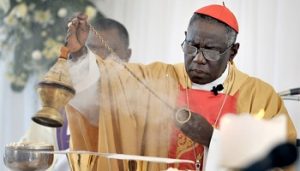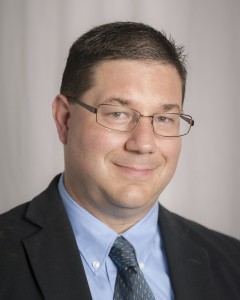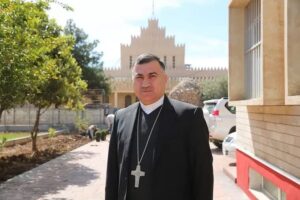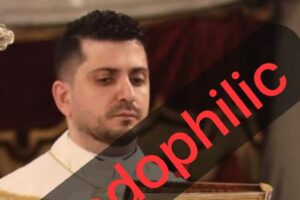It’s a bit rich to accuse those who would celebrate our Holy Mass “ad orientem” of exercising mere personal preference and risking unity, when so much liturgical abuse rooted in priests’ preferences has gone unchecked and harmed unity.

Dr. Leroy Huizenga
Cardinal Robert Sarah, Prefect of the Congregation for Divine Worship and the Discipline of the Sacraments (CDW for short), gave a beautiful barnburner of a speech last week at the Sacra Liturgia conference in London. Among many other wonderful things, Cardinal Sarah emphasized the importance of ad orientem priestly posture at the Mass. In the ad orientem posture the priest faces the same direction as the people for the majority of the Mass, as priest and people gaze on the crucifix presenting the crucified Lord together anticipating his second coming. The Latin ad orientem means “to the east,” the “orient,” the direction in which Jerusalem lies and the direction from which Jesus teaches he will return in Matthew 24:27: “For as the lightning comes from the east and shines as far as the west, so will be the coming of the Son of man.” Cardinal Sarah, prefect of the CDW appointed by Francis, said at several points that Francis wishes him to promote and enact various reforms of the reform of the liturgy and suggested that priests begin celebrating Mass using the ad orientem posture this coming Advent.
Cardinal Nichols, Archbishop of Westminster, just sent a letter to his priests discouraging them from celebrating Mass ad orientem, claiming that doing so would be an exercise in mere “personal preference or taste”. Moreover, Cardinal Nichols also pointed his priestly readers’ attention to the General Instruction of the Roman Missal (the GIRM in shorthand) no. 299, which Nichols claims supports versus populum posture in which the priest faces the people from behind the altar, and further suggested that celebrating ad orientem threatens “the integrity and unity of the Roman rite.” (On Monday, the Vatican Press Office issued a statement denying that any formal instruction requiring the ad orientem posture is forthcoming. Unfortunately, it confuses matters regarding the two forms of the Mass, as if the ad orientem posture belonged to the Extraordinary Form alone.)
It’s a bit rich to accuse those who would celebrate our Holy Mass ad orientem of exercising mere personal preference and risking unity, when so much liturgical abuse rooted in priests’ preferences has gone unchecked and harmed unity. So let’s ask the obvious question: Why did Cardinal Sarah, appointed by Francis to serve as prefect of the CDW, advocate the priestly posture of ad orientem? Here’s what Cardinal Sarah said in the now-official transcript of his remarks:
I want to make an appeal to all priests. You may have read my article in L’Osservatore Romano one year ago (12 June 2015) or my interview with the journal Famille Chrétienne in May of this year. On both occasions I said that I believe that it is very important that we return as soon as possible to a common orientation, of priests and the faithful turned together in the same direction—Eastwards or at least towards the apse—to the Lord who comes, in those parts of the liturgical rites when we are addressing God. This practice is permitted by current liturgical legislation. It is perfectly legitimate in the modern rite. Indeed, I think it is a very important step in ensuring that in our celebrations the Lord is truly at the centre.And so, dear Fathers, I humbly and fraternally ask you to implement this practice wherever possible, with prudence and with the necessary catechesis, certainly, but also with a pastor’s confidence that this is something good for the Church, something good for our people. Your own pastoral judgement will determine how and when this is possible, but perhaps beginning this on the first Sunday of Advent this year, when we attend ‘the Lord who will come’ and ‘who will not delay’ (see: Introit, Mass of Wednesday of the first week of Advent) may be a very good time to do this. Dear Fathers, we should listen again to the lament of God proclaimed by the prophet Jeremiah: “they have turned their backs to me and not their faces” (2:27). Let us turn again towards the Lord! Since the day of his Baptism, the Christian knows only one direction: the Orient. “You entered to confront your enemy, for you intended to renounce him to his face. You turned toward the East (ad Orientem), for one who renounces the devil turns towards Christ and fixes his gaze directly on Him” (From the beginning of the Treatise on the Mysteries by Saint Ambrose, Bishop of Milan).
I very humbly and fraternally would like to appeal also to my brother bishops: please lead your priests and people towards the Lord in this way, particularly at large celebrations in your dioceses and in your cathedral. Please form your seminarians in the reality that we are not called to the priesthood to be at the centre of liturgical worship ourselves, but to lead Christ’s faithful to him as fellow worshippers united in the one same act of adoration. Please facilitate this simple but profound reform in your dioceses, your cathedrals, your parishes and your seminaries.
Cardinal Sarah touches on several of the reasons supporters of ad orientem put forth: the posture unites the priest with his people together as they address God; it’s permitted at present (which Cardinal Nichols conceded); it’s the longstanding tradition of the Church (see Ambrose’s quote regarding baptism); it takes the focus off the priest celebrant and puts it on God.
To these may be added others. Above all ad orientem preserves and presents salvation history in the liturgy. It has been the historic norm for Christian worship east and west (early church counterexamples are either misunderstood or the result of awkward church architecture that had the altar on the west end), and so the ad orientem posture keeps with the past, our history, our tradition. The gospel has spread from east to west (consider the missionary account of the book of Acts, in which the action moves from Jerusalem to Rome), and so looking east is a gaze back to where the Church has been, preaching repentance and forgiveness of sins “beginning at Jerusalem” (Luke 24:47). But it is also a gaze to the future: the Lord promised he would return like lightning from the east (Matt. 24:27), and so the ad orientem posture preserves our eschatological expectation as we await the risen Lord together. And in the Mass our Lord actually comes! The Mass is where past and future, earth and heaven, meet in our very present. The Christ whose coming we await comes even now, on the altar, in his precious body and blood.
Because these reasons reflect the historic liturgies of the broader church, ad orientem also happens to be ecumenical. I’ve attended Lutheran services where the minister employed the ad orientem posture. With regard to the Orthodox Churches, ad orientem posture in the Latin rite preserves a similar sense of mystery and expectation found in the Orthodox Divine Liturgy, in which priests are hidden behind the iconostasis, the big wall of icons in Orthodox churches, for most of the liturgy. The priest (if there is no deacon) comes out to incense; he also comes through the Holy Doors in the iconostasis to bless the people, to read the Gospel, and to give the homily. And then he also comes out to distribute Holy Communion to the people. And while we’re on the matter of things eastern, the Divine Liturgy of Byzantine Catholicism is the same.
If all is this so, why did the versus populum posture, in which the priest faces the people with his back to Jesus, come into vogue after the Second Vatican Council when the Council itself didn’t suggest or mandate it? The short and charitable answer is good intentions, with assists from bad scholarship, the ideology of antiquarianism, and the ghost of Descartes. The emphasis on the Church as local communities and the Eucharist as a community meal gave insufficient attention to the sacrificial and eschatological dimensions of the Mass, and the desire for community led many to think it a good idea for the priest to face his people. They’d be one community. Many liturgical experts, misreading at the time archaeological and textual witnesses, also claimed that the early church celebrated versus populum as a rule, thus committing the sin of “exaggerated and senseless antiquarianism” Pius XII condemned in Mediator Dei (1947; cf. nos. 61-64). Finally, the modernity in which the Novus Ordo Missae was received is Cartesian in that nothing can be hidden, mysterious; everything must be revealed, clear, distinct. We see this (for example) in modern architecture and dress: major buildings are made of glass, revealing everything with little decoration to hide anything, while clothing habits nowadays leave nothing to the imagination so that men’s and women’s bodies are no longer mysteries hidden but revealed to all. So to with the Mass: the good desire that people understand the Mass led to changes like the elimination of most silence in the Mass and the versus populum posture. The Mass became something intellectual, something to be understood, but the price was the eclipse of the beauty of the revelation of its mysteries.
And so intentions were good; the results, perhaps not. The late Msgr. Klaus Gamber, author of The Reform of the Roman Liturgy: Its Problems and Background (for which book Cardinal Ratzinger wrote an incisive foreword), opined that the versus populum posture was the most destructive liturgical innovation introduced after—but not because of!—the Council. Some who had major hands in the liturgical reforms after the Council, such as Frs. Louis Bouyer and Joseph Jungmann, disavowed their prior support of the new posture. For it closes the congregation in on itself, occluding Christ, occluding the eschaton, occluding God.
And so many have sought a revival of the ad orientem posture as it never should have disappeared. As Cardinal, Joseph Ratzinger wrote the following in The Spirit of the Liturgy:
Despite all the variations in practice that have taken place far into the second millennium, one thing has remained clear for the whole of Christendom: praying toward the east is a tradition that goes back to the beginning. Moreover, it is a fundamental expression of the Christian synthesis of cosmos and history, of being rooted in the once-for-all events of salvation history while going out to meet the Lord who is to come again.
Then having become Pope, Benedict XVI instituted the unofficial “Benedictine Arrangement”—the placing of a crucifix on the altar when celebrating versus populum so that both priest and people might gaze on God together—as a step towards the restoration of ad orientem. (Of course, a funny hiccup has happened on the way to real liturgical renewal…)
So where are we at? Cardinal Sarah’s plea remains, and priests and bishops would do well to heed it, even though the Cardinal did not say it would become an official, required matter (which the Vatican press office was quick to clarify). Indeed, the rubrics for Mass assume the ad orientem posture, and the GIRM—secondary to the rubrics—certainly permit it.
First, the rubrics for the Ordinary Form of the Mass assume ad orientem. Several times we find the priest directed to face the people (cf. e.g. nos. 1, 29, 127, 132, 139, 141), which presumes the priest has been employing the historic posture of ad orientem outside of these points in the liturgy. In fact, no. 133 directs the priest to turn back to the altar!
Second is the matter of the GIRM. Some think it requires the versus populum posture in no. 299, and so Cardinal Nichols adverted to that section in discouraging—forbidding, if honesty prevail—his priests to celebrate Mass ad orientem. The Latin as well as the English translation employed by Cardinal Nichols and others seems muddled. Here’s the Latin text, with translation from Fr. Zuhlsdorf:
Altare maius exstruatur a pariete seiunctum, ut facile circumiri et in eo celebratio versus populum peragi possit, quod expedit ubicumque possibile sit.The main altar should be built separated from the wall, which is useful wherever it is possible, so that it can be easily walked around and a celebration toward the people can be carried out.
That might seem to suggest support of the versus populum posture—it employs those very words—but in a letter of 25 September 2000 (Prot. no. 2036/00/L) the CDW clarified that GIRM no. 299 is only a suggestion that in no way precludes the posture of ad orientem:
The Congregation for Divine Worship and the Discipline of the Sacraments has been asked whether the expression in n. 299 of the Institutio Generalis Missalis Romani constitutes a norm according to which the position of the priest versus absidem [facing the apse, i.e., ad orientem] is to be excluded. The Congregation for Divine Worship and the Discipline of the Sacraments, after mature reflection and in light of liturgical precedents, responds:Negatively, and in accordance with the following explanation.
The explanation includes different elements which must be taken into account. First, the word expedit does not constitute a strict obligation but a suggestion that refers to the construction of the altar a pariete sejunctum (detached from the wall). It does not require, for example, that existing altars be pulled away from the wall. The phrase ubi possibile sit (where it is possible) refers to, for example, the topography of the place, the availability of space, the artistic value of the existing altar, the sensibility of the people participating in the celebrations in a particular church, etc.
In sum: The ad orientem posture is historic, is good praxis rooted in good liturgical theology, is assumed by the rubrics, and is permitted by the GIRM as confirmed by the CDW. So take courage, Fathers. Face Jesus with us this Advent.
Since we’re in an age when personal narratives are supposed to be compelling, I here offer mine. Like many younger people, I’m searching for gravity, stability, and transcendence for me and my family in this age of supreme artificiality and superficiality that seems to be spinning wildly out of control. That’s largely the presenting reason I became Catholic, and a lot of us become Catholic: even the best forms of evangelical and Protestant Christianity on offer today seem thin compared to riches of the Catholic Faith, in spite of the myriad problems afflicting the Catholic Church to the present day.
My search for depth and transcendence took me to the Mass in the Roman Rite in both forms, ordinary and extraordinary, as well as Byzantine Catholic liturgies. Even the plainest Ordinary Form Mass I found richer than Protestant worship services and Anglican liturgies. (It does one well when temped to liturgical frustration to visit, or at least reflect upon, evangelical or Protestant services; one will miss the things even minimalist Masses have at a minimum: kneeling, crossing, the simplest set prayers.) And so I was drawn to the Mass at local, suburban, “Vatican II” parishes if for no other reason that (I came to believe) Christ was really there.
I also attended Mass in the Extraordinary Form at places like St. John Cantius and Ss. Peter and Paul in Naperville, Illinois. The Extraordinary Form, of course, is celebrated ad orientem. It moved me powerfully. After converting and relocating from Illinois to North Dakota, I once had an incredible experience while serving a daily low Mass. I had ascended the steps towards the altar in preparation for the elevation of the host, and knelt. The priest, facing the crucified Lord Jesus to the east, turned around, with Jesus consecrated in his hands, and pronounced those most blessed words: Ecce Agnus Dei, ecce qui tollit peccáta mundi.
“Behold the Lamb of God, behold him who takes away the sins of the world.” In that precise moment when the priest turned to face me the reality hit me, and hard: Here was the Lord Jesus Christ, crucified and risen, come from heaven, bringing eternity into my present, then, there, now, to give himself to me. I choked up. I wept. I cried. I’m a big guy from North Dakota—weightlifter, former collegiate athlete, outdoorsman. As a rule, we do not cry. We do feel—but inside. Here I was changed. I grew in grace. I came closer to Christ.
Perhaps more than I ever had before I had a most profound encounter with Jesus. That would be the sort of deep interior encounter in vogue nowadays, which I experienced precisely in the form of the Mass many believe precludes it, thanks to ad orientem—which is not only possible and permitted but liturgically normative for the Ordinary Form.
One wonders when northern Cardinals will begin taking Africans seriously; perhaps if and when Cardinal Sarah is made pope. Regardless of that happy eventuality, immediately after his plea for the ad orientem posture now-Cardinal Sarah reminded his auditors that he and his brother bishops “shall have to answer to the Lord for our stewardship” of the celebration of Holy Mass, to one higher than any bishop, cardinal, or pope. Clergy from lowly parish priests to influential cardinals would do well to listen to his plea. The celebration of Mass ad orientem might remind and prepare them for that eschatological certainty.
[Editor’s note: This post originally stated “Cardinal Nichols, Archbishop of Westminster, attended” the Sacra Liturgia 2016 event. That is incorrect: Cardinal Nichols did not attend the event, but did send a letter of welcome.]
Dr. Leroy Huizenga is Administrative Chair of Human and Divine Sciences at the University of Mary in Bismarck, N.D. Dr. Huizenga has a B.A. in Religion from Jamestown College (N.D.), a Master of Divinity from Princeton Theological Seminary, and a Ph.D. in New Testament from Duke University. During his doctoral studies he received a Fulbright Grant to study and teach at Johann Wolfgang Goethe-Universität in Frankfurt, Germany. After teaching at Wheaton College (Ill.) for five years, Dr. Huizenga was reconciled with the Catholic Church at the Easter Vigil of 2011. Dr. Huizenga is the author of The New Isaac: Tradition and Intertextuality in the Gospel of Matthew and co-editor of Reading the Bible Intertextually.
http://www.catholicworldreport.com/Blog/4917/ad_orientem_nunc.aspx















